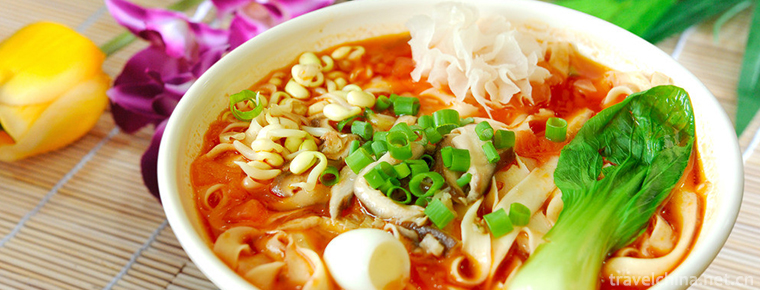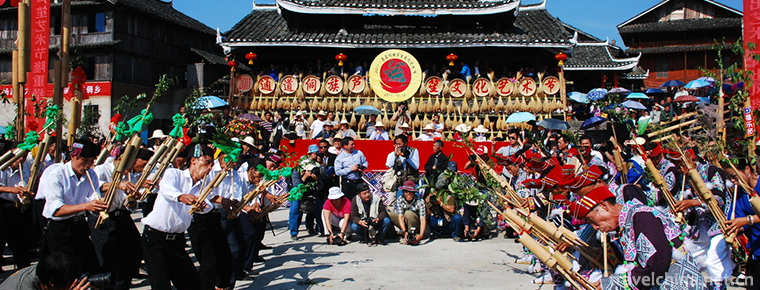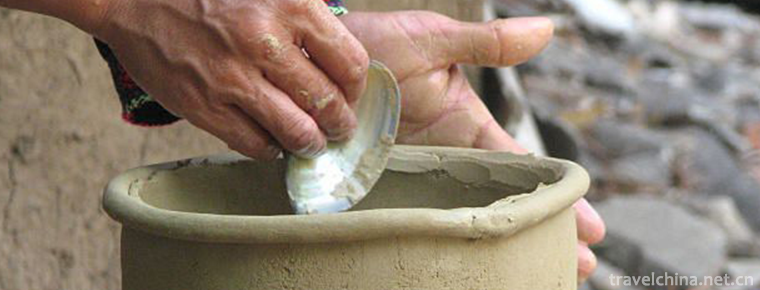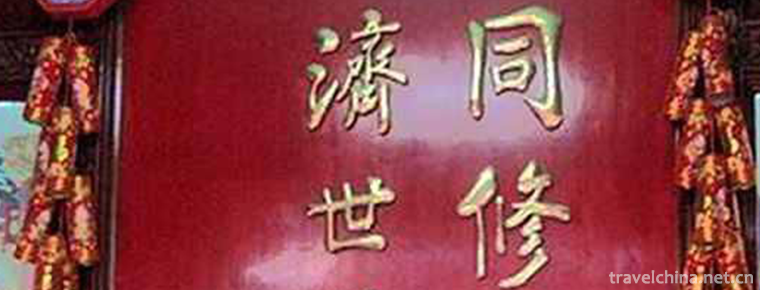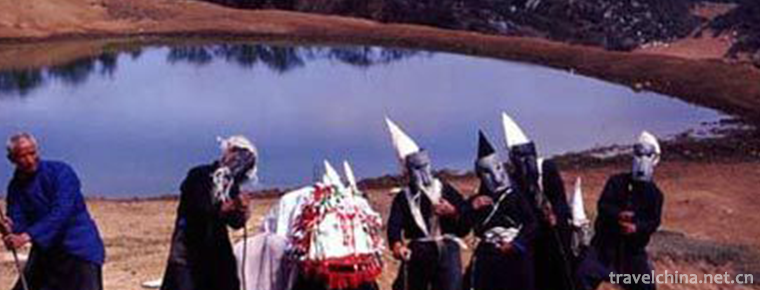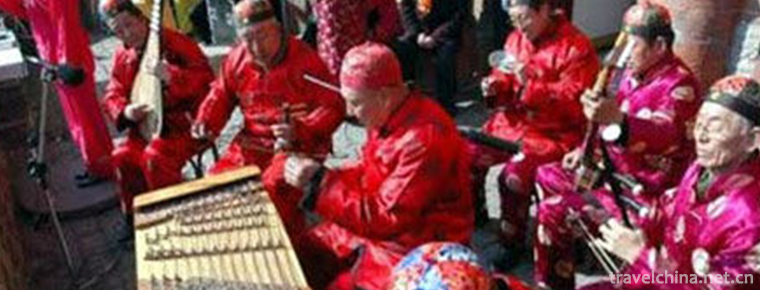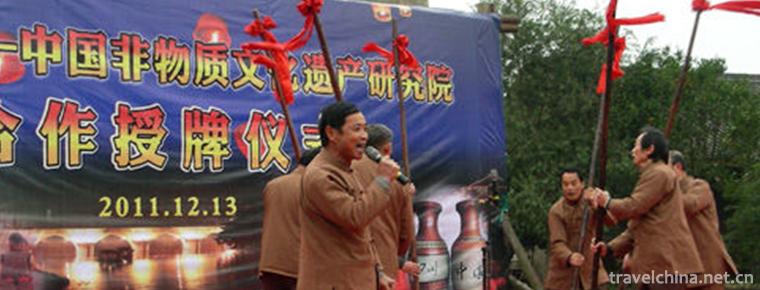Daoism in Northern Shaanxi
Daoism in Northern Shaanxi
As one of the traditional folk songs in northern Shaanxi, Daoqing in northern Shaanxi was originally called "Qingjian Daoqing". Later, because "Longdong Daoqing" and "Shenchi Daoqing" in Shanxi flowed into northern Shaanxi, they formed "three-sided Daoqing" and "Shenfu Daoqing", so they were collectively called "Daoqing in northern Shaanxi". Popular in Qingjian, Zichang, Zhidan, Wuqi, Suide, Yulin, Zizhou, Dingbian, Jingbian, Shenmu, Fugu and other places.
On June 7, 2008, the "Daoqing of Northern Shaanxi" declared by Yan'an City and Qingjian County of Shaanxi Province was listed in the second batch of national intangible cultural heritage list with the approval of the State Council.
Heritage serial number: 772V-79.
historical origin
Taoist sentiment is named for the reason of ancient Taoist priests in chanting sutras, singing and chanting Taoism. According to Tang Shu Li Yue Zhi's statement that "Taoist sentiment, Buddhist singing, Confucian singing theory, or Taoist sentiment, or Taoist sentiment, is the same name as Faqu", the Taoist sentiment originated in the Tang Dynasty, and was first chanted in Taoist view as "classical rhyme" and its style was praised by poems. Body. Later, it absorbed the tunes and music cards, and evolved into a "new classical rhyme" sung in folk sermons, also known as "Tao Song".
In Tang Dynasty, the imperial power was closely related to Taoism, which was regarded as the national religion. In order to maintain the status of Taoism and strive for believers, Taoists sang Taoist stories in the Daoist temple. In order to attract more audiences, folk tales and historical legends were used to sing, and gradually the rap and singing in Taoist courtyards were spread to the people. The creation and development of post-Confucian artists formed a simple and earliest form of Taoist solo singing and rap. This is how Taoist sentiment rose with the prosperity of Taoism.
In the Song Dynasty, Taoism was taken as the orthodox religion and the Taoist doctrine was vigorously promoted. Zhenzong respected Lao Tzu as "Tai Shang Lao Jun, Mixed Yuan Shang De Emperor", and built a magnificent Zhaoying Palace and Huiling View. Later, the maze of Huizong was more than that of Zhenzong, and the concept of monastery was widely practiced throughout the country, resulting in a sharp increase in monasteries and Taoists. This enlarged and developed the Taoist sentiment popular among the people at that time, which was mainly manifested in the use of accompaniment instruments such as pipa, drums, bells and gowns in the Tang Dynasty, and the addition of fishing drums and simple boards, the main instruments still used by Taoist sentiment up to now, which promoted the establishment of the musical form and the formation of the style of Taoist sentiment singing.
In the Yuan Dynasty, Genghis Khan, the ancestor of the Yuan Dynasty, and Kublai Khan, the ancestors of the Yuan Dynasty, all resorted to Taoism in order to unify China. They banned the operas that promoted the rule of the Han nationality, but seldom interfered with the operas of immortality and Taoism. Therefore, the opera writers of the Yuan Dynasty wrote the operas of eight holes and immortality and Taoism, which accounted for more than a quarter of the operas of the Yuan Dynasty. At this time, Taoism, which has been widely popular among the people, has entered a new period of development. It has developed from class singing to square performances. On the original basis, shadow plays have been added, and it has become a pair of singing performances with characters and plots, as a prototype of opera.
In the Qing Dynasty, Lamaism was more important and Taoism was at a low ebb. However, because Cixi's dream of immortality, Taoist priest Gao Yunxi "confused Cixi with the magic of immortals, and only a few days after entering the palace", and secretly participated in the court affairs, Taoism continued, and at this time the Taoist sentiment continued to develop. Some scholars have followed the old tune to create new tunes, which enriches the expression of Taoist sentiment. Taoist sentiment is mainly composed of "playing with children", "Qingjiang Yin", "covering Luopao" and so on. It also absorbs and adopts some gongs and drums, singing tunes, performances, repertoires and folk operas of Qin Opera and other Bangzi Opera, and gradually forms into mature Taoist sentiment operas.
From such a gradual development process as rap, sitting and singing, make-up performances and stage performances, we can see that Taoist sentiment is not only derived from Taoism, but also closely related to Taoism in its formation and development process, and it is an opera art form that can not be separated from Taoism.
Daoism in northern Shaanxi first appeared in Xuanwu Village of Dongjiejiagou, Qingjian County. According to Wang Rulun, the village's Taoist lover, a group of Taoist lover artists from Xinzhou, Shanxi Province, came to perform in the village and nearby Zhaigou during the Qingdaoguang period (1821-1850), and began to introduce Shanxi Taoist sentiment into Qingjian. Later, it combined with local folk songs and absorbed the artistic elements of Meihu and Yangko, forming the Qingjian Dao sentiment. The earliest group performance was Wang Julun's grandfather, called Wang Jiaban, who performed in the form of sitting and singing. From the Guangxu period to the 1930s, there appeared Taoist groups in the villages of Shijiahe, Yantou, Yuanjiahe and Letangbao in Qingjian County. They often go out to perform, so that Taoist opera spread to Zizhou, Zichang, Zhidan, Hengshan, Suide and other places, the prosperity of the village community has a team. The form of performance has changed from sitting and singing to stage performance, and has become the main entertainment of temple fairs in various places. Often it's the daytime performance of Dao Qing opera and the evening fire of Yangge club. Every year during the Spring Festival, the Taoist sentiments and Yangko teams of villages and villages also carry out mutual invitation performances in the form of placards and returning placards, which are known locally as popular performances.
In the twenty-fourth year of the Republic of China (1935), the Long March of the Red Army arrived in northern Shaanxi, and the Daoism of northern Shaanxi entered a new stage of development. On the basis of traditional Taoist sentiment, Taoist artists created a new Taoist sentiment in Hengshan and other places. Because they performed many modern plays reflecting the revolutionary struggle life of the people in the Shaanxi-Gansu-Ningxia Border Region, they were called "turning over Taoist sentiment" by the masses. The artistic style is quite different from the old Taoism. The old Taoism is deep and solemn. The new Taoism is joyful, bold and bright. It is full of new characteristics of the times and is generally welcomed. As a result of the decline of the old Taoist sentiment, classes in urban and rural areas have changed to sing new Taoist sentiments, such as Xiawucun Ban in Qingjian, Caojia Talban, Chen Jiaping Ban, Pojiagou Ban, Badoucha Ban, Huaijiawan Ban, Daoluo Village Ban in Hengshan, Chaixinliang Ban, Peijiawan Ban in Zizhou, Qiangjiagou Ban Ban, Liu Jiachuan Ban, Zichang Qiangjiagou Ban Ban, Chuanbao Ban Ban in Yulin Town, Baijiahe Ban, etc.
After the founding of the People's Republic of China, the new Taoist conditions in northern Shaanxi have further developed. The non-governmental class clubs in various villages and fortresses have been expanding continuously. Some class clubs have also purchased new boxes, trained a new generation of actors, and created and performed a large number of modern plays.
It is mainly distributed in Yan'an and Yulin areas of northern Shaanxi. The most concentrated are Zichang County, Yanchuan County and Qingjian County. Its radiation area extends to Hetao, Inner Mongolia, northwest Shanxi, Gansu and Ningxia, which are close to northern Shaanxi.
Art School
As one of the local operas in northern Shaanxi, Daoqing can be divided into Donglu Daoqing, Xilu Daoqing and Qingjian Daoqing according to its popular region and artistic characteristics.
Donglu Daoqing refers to the Daoqing which was introduced from Linxian County in Shanxi Province to Fugu County and Shenmu County in the early years of the Republic of China and developed by combining local languages and folk songs.
Western Road Daoqing refers to the Daoqing evolved from the Longdong area of Gansu Province, through shadow play, social fire and other means, into Dingbian, Jingbian, Hengshan and other counties with the combination of local language and folk songs.
Qingjian Daoqing refers to the Daoqing which is spread in Qingjian County and its adjacent districts. Among them, Qingjian Daoqing is the most popular and representative, which is known as the "authentic Daoqing in northern Shaanxi".
Tune Development
Daoqing music in northern Shaanxi is composed of two tunes: East Road and West road. East Road is the new tune, West Road is the old tune. Its modes are different, the eastern way is levy mode and the Western way is commercial mode. But the names of the two tones are basically the same. Its voice is high and bold, tender and delicate, both masculine and Yuefu style.
There are more than 20 kinds of tunes, such as "flat tune", "local character tune", "cross tune", "playing children", "final South tune", "high tune", "Yangbei tune", "two-five-hammer", "eight-character tune", "Taiping tune", "Langtang tune", "golden knot tune". Each tune has "flat plate", "positive plate", "falling plate", "substitute plate", "guide plate" and other plate heads and tails. There are six characters, eight characters and cross sentences in the melody of "Mayun" in Wubanqiang. There are also three characters and four characters in the melody. Four sentences and one paragraph.
Accompaniment music is divided into civil and military scenes. The instruments in Wenchang are small three strings, four tones (making bows with four strings and two horsetails), and tubes, which are called three major pieces. Wuchang has simple boards, fishing drums and brittle drums and small hinges which are unique to Daoqing in northern Shaanxi, which constitute the prominent characteristics of Daoqing music in northern Shaanxi.
After the artists'transformation, the composition of the new Taoist singing style has been increasing, such as "second-rate board", "big starting board" and "arrow board". On musical instruments, Banhu was used as the main performance, and violin, piano and flute were added, which enriched the musical expression. On the basis of four tones, a pianist in Luoer Lane, Qingjian, has reformed a kind of six tones, which is appreciated by the audience.
Inheritance and Protection
virtuoso
Musician
Tian Si, Ren Linzhong, Liu Zhongzhong, Cao Cunshu, Bai Shiliang, Golden Tuan, Liu Yonghai, Bai Fenghai, Li Zhenyou, Zhang Yuhe, Guo Zhanshan, Zhang Chengxiang, etc.
performer
Qianglian Associated Press, Qiangsan, Qiangdekui, Zhang Haisheng, Zhang Guocang, Zhang Guowan, Liu Hanzhu, Huang Deming, Li Xianghai, Bailin, Liu Yongyi, Li Jingsheng, Huikejian, Li Peicheng, Guo Lucai, Huiwannian, Huiwanguo, etc.
Inheritance pedigree
Oral and oral transmission is adopted. The main forms of inheritance are family inheritance and regional inheritance.
1. Family inheritance: from father to son, from descendant to descendant, from generation to generation. The typical family is Huiwannian family in Gaojiahe Village, Yanchuan County. Its pedigree is: the first generation: Huiwannian father (late Qing Dynasty) - the second generation: Huiwannian-the third generation: Huibin Jie (son of Huiwannian), Gao Xiaoqin (daughter-in-law of Huiwannian), Huiwuzi (five children of Huiwannian) - the fourth generation: Huizhiyong (elder grandson of Huiwannian), Huiwannian. Hui Xinyan (granddaughter of Hui Wannian).
2. Regional inheritance: from family inheritance to family inheritance, such as the village as the unit of inheritance of Qiangjiagou Road in Zichang County, whose pedigree is based on the village: the first generation: strong (late Qing Dynasty to early Republic of China) - the second generation: unyielding, strong growth, strong literary breadth, strong literary achievements, etc. - the third generation: strong Meigong, strong intellectual competence, Ren Xianzhou, etc. - the fourth generation: strong Shibin, strong Dehua, strong Wencheng, etc. Qiang Dezhe et al. - Fifth Generation: Qiang Dekui et al. - Sixth Generation: Qiang Associated Press, Qiang Ai Society, Jing Tiaoxia, Qiang San, Qiang IV, Qiang Zheng Society, Chen Chunfeng, etc. - Seventh Generation: Qiang Jiaojiao, Qiang Kai, Qiang Shanshan, Qiang Boda, etc.
Current status of protection
1. Old artists die year by year, leaving fewer and fewer things, some of the original scripts have disappeared.
2. Today, 90% of Taoist performance activities are rural temple fairs, which are only popular, not improved, and have a downward trend.
3. There are few young people who know how to give up love, and there are few successors. If they do not grasp it again, it will be lost and extinct.
4. Lack of specialists.
Inheritance Significance
1. The Daoism of Northern Shaanxi retains many primitive and traditional cultures. Regardless of the script structure, language style has the meaning of living fossils.
2. Music is quite different from the folk songs and storytelling music in northern Shaanxi. It retains the great Taoist music style. It has its unique artistic value.
3. It played an irreplaceable role in the new literary movement.
4. It is a popular art form among the people in northern Shaanxi.

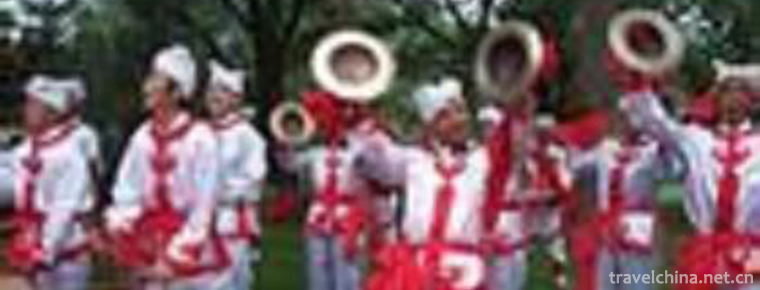
-
Alice tomato noodles
The Ali brand was born in 2001 and officially launched in 2005. The brand popularity and honor of Ali Juice Noodle series products are constantly improving.
Views: 239 Time 2018-11-26 -
Ancient songs of Miao Nationality
Miao Ancient Songs, local traditional folk literature in Taijiang County and Huangping County of Guizhou Province, is one of the national intangible cultural heritage..
Views: 220 Time 2018-12-15 -
Miyuan Yunding Paradise
Miyuan Yunding Paradise Park is located in Chongli District, Zhangjiakou City, Hebei Province, 220 km from Beijing, only 50 minutes after the completion of the high-speed railway.
Views: 137 Time 2019-02-07 -
Primitive Pottery Making Skills of Li Nationality
The primitive pottery making technique of Li nationality, the traditional handicraft technique of Changjiang Li Autonomous County, Hainan Province, is one of the national intangible cultural heritages.
Views: 181 Time 2019-05-13 -
Tongrentang Traditional Chinese Medicine Culture
Tongrentang Traditional Chinese Medicine Culture, one of the traditional Chinese medicine, is declared by Beijing Tongrentang (Group) Co., Ltd., one of the national intangible cultural heritage..
Views: 189 Time 2019-06-21 -
Taiji of Yi Nationality
Qitaiji is an ancient form of drama that only exists in Nugazhai village, Bandi Township, Weining Yi Hui Miao Autonomous County, Guizhou Province. Taiji is the transliteration of Yi, the word "Qi.
Views: 398 Time 2019-07-12 -
Yulin Xiaoqu
The lyrics of Yulin Xiaoqu are integrated with elegance and vulgarity. In terms of language style and structure, there are not only words used by ordinary scholars, but also local dialects and dialect.
Views: 165 Time 2019-07-14 -
Make a chant
Bamboo and hemp trumpet is a traditional folk song of Qionglai City, Sichuan Province. It belongs to a kind of labor trumpet sung by local papermaking workers when playing bamboo and hemp. It is mainl.
Views: 147 Time 2019-08-03 -
Chengdu Dien Photoelectric Technology Company
As an energetic, young crystalline materials technology company, DIEN TECH specializes in the research, design, manufacture,and sell of a series of nonlinear optical crystals, laser crystals, magneto-.
Views: 396 Time 2019-09-11 -
Dragon elbow mountain
Longcub mountain, also known as yuxu mountain, is located in Longquan Township, northwest of Huili County, Liangshan Yi Autonomous Prefecture, Sichuan Province, China. It is also known as yuxu mountain at the junction of Baiguowan .
Views: 346 Time 2020-10-16 -
The changing style of Cheongsam
After a hundred years of evolution, with the change of people's life style and aesthetic taste, cheongsam has developed a variety of styles, which makes people dazzled. In the golden age of the development of Cheongsam in the 1930s and 1940s, the styles of cheongsam changed .
Views: 309 Time 2020-12-11 -
Suining City Construction
In 2019, Suining completed the investment of 4.991 billion yuan in municipal infrastructure construction. The green space rate of the built-up area is 34.46%, the green coverage rate of the built-up area is 39.6%, and the per capita green space area of the park is 12.42 square meters..
Views: 143 Time 2020-12-16
